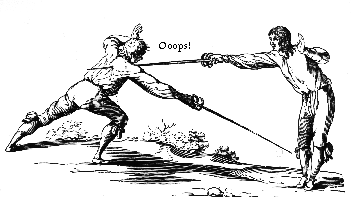Fencing Safety

Newcomers to fencing often express concerns about their safety. Foremost on the minds of many is the question of whether one can be stabbed, possibly even killed while fencing. After all, doesn't fencing have something to do with swords and sword fighting? The image above explains in graphic terms what fencing masters of the past have taught their pupils. The beginning fencer's concerns are reasonable ones.
Like virtually everything in life, fencing comes with risks. To evaluate the risk in a meaningful way it may be helpful to compare the risks inherent in other activities. For example, in 1997 approximately 3,100 adults accidentally inhaled food while eating and choked to death. That same year there were 4000 deaths by drowning in the United States, 14,900 from accidental falls, and 43,200 by motor vehicle accidents (1). There were 36 skiing and snowboarding fatalities in the US during the 1996-97 season, with serious head and spinal injuries occurring at the rate of approximately 29 each year (2). In 1997, 808 bicyclists lost their lives (3) on America's public thoroughfares and more than 80% of 650 mountain bikers who participated in surveys (4-7) were injured in off-road crashes during a one year period. Broken bones consistently accounted for 20% to 30% of the total and brain concussions for 3% to 12% (7-11).
In the United States there has been but a single death caused by a fencing accident. The mishap took place more than a century ago, in 1892, and was caused by a failure of the victim's mask. The most common injuries sustained today by fencers are pulled muscles and trauma to tendons and to the ligaments of the knees and ankles. "Fencer's elbow," a medical problem experienced by some fencers, is also known by tennis players as "tennis elbow," or lateral epicondylitis. Infrequently, a weapon's blade may break posing a serious danger, but sturdy masks and modern fabrics provide excellent protection and have made fencing a very safe activity. Most fencers enjoy fencing throughout their lives without experiencing anything more than an occasional case of muscle soreness. Accidents can befall fencers as they do the adherents of any sport, but chances are that the greatest fencing-realted danger any fencer will ever face will lie in risking a motor vehicle accident while driving to the fencing school.
Fencing Safety Rules
Since it's beginning in 1990 La Spada Nemica has never had an accident. The following safety rules are observed by this school:
- Never cross blades, for any reason without first putting on your mask!
- Most fencing injuries are from muscle, ligament and tendon trauma. Always warm up before fencing.
- Don't wear clothing with holes. A trapped blade in your clothing could cause a serious accident.
- Novices may use practice jackets but advanced fencers must wear jackets and underarm protectors.
- Men must wear athletic supporters with a protective shield. Women must wear breast protectors.
- Legs must be protected with sweat pants, trousers or fencing breeches.
- Be aware of your surroundings. Don't step out onto the active floor without looking to be sure it's safe.
- When fencing, do not drive your opponent into the wall or a hazard in your eagerness to win a touch.
- Inspect your weapon periodically; see that the blade's curve is uniform and that the button is secure.
- Be mindful of your fencing distance; don't fence too close!
- If you are repeatedly colliding with your opponent, stop fencing until you can correct the error.
- Aggressive fencing is OK; violent, uncontrolled fencing is not. Nothing you do should cause pain or harm.
- When hit, don't point at the area, with your finger, but simply, immediately, acknowledge the touch in a clear, audible voice.
- First, last and always, never — EVER — cross blades unless you have first
PUT ON YOUR MASK!
References for accident data cited above:
- National Safety Council
- National Ski Areas Association: Lakewood, Colo.
- Insurance Institute for Highway Safety.
- Chow TK, Bracker MD, Patrick K: Acute injuries from mountain biking. West J Med 1993;159(2):145-148
- Pfeiffer RP: Injuries in NORBA pro/elite category off-road bicycle competitors. Cycling Sci 1993;5(1):21-24
- Pfeiffer RP: Off-road bicycle racing injuries: the NORBA pro/elite category. Clin Sports Med1994;13(1):207-218
- Kronisch RL, Rubin AL: Traumatic injuries in off-road bicycling. Clin J Sport Med 1994;4(4):240-244
- Pfeiffer RP, Kronisch RL: Off-road cycling injuries, an overview. Sports Med 1995;19(5):311-325
- Kronisch RL, Chow TK, Simon LM, et al: Acute injuries in off-road bicycle racing. Am J Sports Med 1996;24(1):88-93
- Kronisch RL, Pfeiffer RP, Chow TK: Acute injuries in cross-country and downhill off-road bicycle racing. Med Sci Sports Exerc 1996;28(11):1351-1355
- Rivara FP, Thompson DC, Thompson RS, et al: Injuries involving off-road cycling. J Fam Pract 1997;44(5):481- 485